Program 
The tentative program is as follows
08:30 - 10:00         Elevator pitches/introductions
10:00 - 10:30         Frontiers in Science talk I Functional genomic and population genetic analyses of development and    
                                 ageing by Dr. Mikhail Spivakov, 
10:30 - 11:00¬†¬†¬†¬†¬†¬†¬†¬† Frontiers in Science talk II¬†‚ÄúAbout My Lab‚ÄĚ, a new series of publications at PLoS Computational ¬†
                                 Biology by Dr. Theodore Alexandrov
11:00 - 11:30         Coffee break
11:30 - 12:00         Frontiers in Science talk III Detection and Integrative Functional Characterization of DNA 
                                 Modifications with Single Molecule Real-Time Sequencing by Dr. Gang Fang
12:00 - 12:30         Frontiers in Science talk IV Systems Biology methods for image analysis in development and
                                 disease by Dr. Luis M Escudero
12:30 - 13:30         Lunch break
13:30 - 14:30         Keynote lecture by Prof. Jean Peccoud, Virginia Bioinformatics Institute
14:30 - 16:00         Roundtable discussion
16:00 - 16:30         Coffee break
16:30 - 18:00         Roundtable presentations & Wrap-up
20:00 -   --               Dinner
 

Dr. Jean Peccoud, Associate Professor, Virginia Bioinformatics Institute 
Title of the talk: 
The A-Myth: why you should run your lab as a business
 
Abstract
A-Myth stands for ‚ÄúThe Academic Myth.‚ÄĚ I want to challenge the conventional wisdom that research groups in academia should not be managed as businesses. It is tempting to take cover behind our non-profit status, our noble pursuit of knowledge, and other excuses to dismiss the idea that management methods used to run for-profit organizations do not apply to academic research groups or research institutes. Our metrics of success may not be the same but we will see that the methods to reach our own success may not be that different.
 
Bio
Jean Peccoud is an expert in computational synthetic biology.  His current scientific interests include the development of linguistic models of DNA sequences, the optimization of DNA fabrication processes, and the development of new instruments to measure the dynamics of gene networks in live cells.  Dr Peccoud’s group is leading the development of GenoCAD, an open source web-based application to design synthetic DNA molecules from libraries of standard genetic parts.  In the 1990s, Dr Peccoud pioneered the development of stochastic models of genetic networks.
Dr Peccoud joined the Virginia Bioinformatics Institute at Virginia Tech in 2006 as Associate Professor. Prior to joining VBI, he was involved in a research program at Du Pont focused on gene and regulatory network discovery, the design of DNA transformation vectors, and the development of methods to analyze the genetic properties of gene networks. Dr Peccoud has been a visiting professor in the department of electrical engineering at the University of Washington, a visiting scholar with Wolfram Research, and the recipient of a NATO Fellowship. Since 2009, he has been an Academic Editor of PLoS ONE. He co-edits the PLoS ONE Synthetic Biology Collection. He is also a member of the editorial board of Trends in Biotechnology.
 

Dr. Mikhail Spivakov, Group Leader, Regulatory Genomics, The Babraham Institute, Cambridge, United Kingdom
 
Title of the talk: Functional genomic and population genetic analyses of development and ageing
 
Abstract
The advent of sequencing technologies has boosted both regulatory genomics and population genetics, two research disciplines that have remained very separate for a long time. We are now at a stage - both technically and conceptually - to benefit the most from working at the intersection of these two fields. I will highlight some work by myself and others in this direction and discuss some emerging phenomena that it has identified
 
Bio
Mikhail Spivakov graduated from Department of Biology at Moscow State University in 2002 and moved to London to do a PhD with Amanda Fisher and Matthias Merkenschlager at MRC Clinical Sciences Centre (Imperial College). His PhD projects investigated chromatin events underlying cell differentiation, and about half of his work was ‚Äėwet-lab‚Äô and half computational.
Mikhail then joined EMBL on an Interdisciplinary Fellowship to work with Ewan Birney (EMBL-EBI, near Cambridge) and Eileen Furlong (EMBL Heidelberg) on the regulatory organization of cardiac enhancers. At EMBL, he also contributed to the ENCODE project, studying the population genetics of transcription factor binding sites. In addition, Mikhail has been involved in the establishment of a population genomics resource in medaka fish that will become available in 2014. In November 2012, Mikhail started a Regulatory Genomics group at the Babraham Institute as part of the Nuclear Dynamics Programme.
 
 
Dr. Theodore Alexandrov, MALDI Imaging Lab / Center for Industrial Mathematics, University of Bremen, Bremen, Germany; Steinbeis Innovation Center SCiLS Research, Bremen, Germany; Skaggs School of Pharmacy and Pharmaceutical Sciences, University of California San Diego, La Jolla, CA, USA
 
Title of the talk:¬†‚ÄúAbout My Lab‚ÄĚ, a new series of publications at PLoS Computational Biology
 
Abstract
We announce a new series of publications ‚ÄúAbout My Lab‚ÄĚ for PLoS Computational Biology which will be devoted to questions on how to run a research lab to success and to escape the common pitfalls on this way.
A research lab is the workhorse of modern science. Running a research lab, whether it is a wet lab, dry lab, or both, is a complex and costly endeavor, which requires a talented team, solid funding, lab space, and a principal investigator (PI). The success of a lab is normally associated with its PI and indeed very much depends on their scientific achievements (hence vision), productivity, and, importantly, their management skills. Management skills are essential, and it’s especially surprising that with the size and turnover of a lab being comparable to that of a small company, scientific PIs do not normally have formal management training and instead are typically self-made managers.
For a young PI at the beginning of their independent career, it is especially important to learn more about running a successful lab. Many questions pave the way: how to motivate team members; how to organize communication; how to handle conflicts inside the team; how to deal with increasing flows of information, the growing number of emails, university commitments, and publications.
Our motivation in creating the series of publications ‚ÄúAbout My Lab‚ÄĚ at PLoS Computational Biology is to share knowledge on these questions with respect to lab management. We will raise awareness of the role of management in science, and provide an open platform for disseminating experience and opinions on this topic.¬†
 
Bio
Theodore Alexandrov received his PhD in 2007 in mathematics at St. Petersburg State University, Russia. He started his postdoc at Center for Industrial Mathematics, University of Bremen, and then coordinated the international PhD program Scientific Computing in Engineering. Since 2010, he is the head of Life Science group at Center for Industrial Mathematics. Since 2010, he is a visiting researcher at University of California San Diego, first at NIH Center for Computational Mass Spectrometry and now at Skaggs School of Pharmacy. Since 2011, he is the head of MALDI Imaging Lab at Departments of Biochemistry and Mathematics, University of Bremen. He is the coordinator of EU FP7 HEALTH project 3D-MASSOMICS and a co-founder and the scientific managing director of both Steinbeis Innovation Center SCiLS Research and SCiLS GmbH developing software for imaging mass spectrometry.
 
 
 
Dr. Gang Fang, Assistant Professor, Department of Genetics and Genomic Sciences, Institute for Genomics and Multi-scale Biology, Mount Sinai School of Medicine, New YorK, USA
 
Title of the talk: Detection and Integrative Functional Characterization of DNA Modifications with Single Molecule Real-Time Sequencing
 
Abstract
The information content of the genetic code is not limited to the primary nucleotide sequence but is also conveyed by chemical modifications of individual bases. These modifications expand the genetic alphabet beyond the canonical deoxyribonucleotides (A, G, C and T) and provide rich additional information that is critical towards a complete understanding of the regulatory networks that modulate core cellular and biological processes under a great diversity of conditions. The most common mapping of genome-wide methylation occurs via bisulfite sequencing that specifically targets 5-methylcytosine residues. However, a variety of other chemical modifications such as 6-methyladenine, 4-methylcytosine, and 8-oxoguanine cannot be detected accurately and efficiently on a genome-wide scale using second-generation sequencing techniques, and the functional impacts of these DNA chemical modifications have not been fully explored. Recently, a third generation sequencing technique, namely Single Molecule Real-Time (SMRT) sequencing and proper statistical modeling, enabled the direct detection of and differentiation among tens of known and potentially novel DNA modifications. Some of these DNA modifications have been demonstrated to have important regulatory roles in the context of infectious diseases and genetic disorders. I will highlight works done by ourselves and others in this direction and discuss potentials for future research work.
 
Bio
Gang Fang is an Assistant Professor in the Department of Genetics and Genomic Sciences at Mount Sinai School of Medicine. He is also a member of the Icahn Institute for Genomics and Multi-scale Biology. He is interested in using data mining, machine learning and computational statistics to answer important questions in biology, genomics and epigenomics. His current research focuses include the detection and functional characterization of DNA modifications and other epigenetic variations in pathogens and host-pathogen interactions, highlighting systems-level integration of multi-scale sequencing data and high-throughput functional genomics assays. His recent work revealed the first single-base resolution bacterial methylome that armed the 2011 German outbreak E. Coli and the first map of putative DNA modifications in a human mitochondrial genome. These discoveries were highlighted by Nature Reviews Genetics, Nature Reviews Microbiology and the Faculty of 1000, and received media coverage including Bio-IT World, TheScientist and PHYS. Gang received his BS from Fudan University in China, MS from University at Buffalo and his PhD from University of Minnesota with Vipin Kumar, all in Computer Science. He also worked with Pacific Biosciences for two years under Eric Schadt and was among the key efforts in the development of statistical models for detecting DNA modifications with Single Molecule Real-Time (SMRT) sequencing data. His PhD thesis on the discovery of combinatorial disease biomarkers and epistasis received the 2013 Best Dissertation Award in Physical Sciences and Engineering from University of Minnesota. He is also a recipient of Best Network Model award and Young Investigator award from Sage Congress 2010, a Walter Barnes Lang Fellowship and a Biomedical Informatics and Computational Biology traineeship from University of Minnesota.
 
 

Dr. Luis M Escudero, Miguel Servet Investigator, Instituto de Biomedicina de Sevilla (IBiS), Hospital Universitario Virgen del Rocio/CSIC/Universidad de Sevilla, Spain
 
Title of the talk: Systems Biology methods for image analysis in development and disease
 
Abstract
The origin of any investigation is based in the observation of the surrounding environment. Scientists have always been recording what they see, trying to understand the logic of natural phenomena. Biology and Medicine are not an exception to this. New advances in imaging technologies appear every day: new types of microscopes, new visualization systems, novel techniques to improve temporal or spatial resolution, etc. This has helped enormously to uncover the cellular and molecular mechanism of lots of biological and biomedical processes. The advance of imaging techniques has been paired with the development of analysis tools that manage large amount of data or that help in data interpretation. Recently, other complementary approaches have been proposed to obtain more information from these types of images. These methods are based in the consideration of biological images as complex systems. The combination of computerized image analysis and network science extracts organizational information from complex images facilitating the interpretation of biological processes in development and disease. I will present different network based approaches that span very diverse topics: from the topological analysis of fly morphogenesis to the investigation of Alzheimer Disease.
 
Bio
I am a biologist with a deep developmental biology background. My PhD work at CBMSO (Madrid, Spain) was the study of the development of the Peripheral Nervous System of Drosophila. Later, I went to the MRC-Laboratory of Molecular Biology (Cambridge, UK) to investigate the mechanisms that control cell shape and epithelial organization during the development of Drosophila. Through this postdoctoral stage I focussed on the design of new imaging techniques to analyze complex morphogenetic events. One of the outcomes of my work was developing a new method that permits objective comparison of epithelial organization. This work brings together concepts from different subject areas such as complex networks, developmental biology, cell biology and computer science. This served as the starting point of my studies as an independent investigator to understand how cells are arranged to form organs and how disease/mutation can alter this organization.
Now, I enjoy a Tenure track position, at Instituto de Biomedicina de Sevilla (Seville, Spain) where I try to incorporate system biology methods to the analysis of biological and biomedical images. My ongoing research has diversified into different projects. For example, we have taken advantage of the close relation between our Institute and the Hospital Virgen del Rocío to develop NDICIA, a method for the diagnosis of neuromuscular diseases that we have already published and patented. In a more basic aspect of our current investigation, we continue using Drosophila as a model system for the topological analysis of epithelial morphogenesis. 
 
Roundtable discussion
One of our most important goals of this meeting is to stimulate peer-to-peer interactions, which requires time and effort. In order to achieve this goal, we have devoted a great amount of time for roundtable discussions, so that delegates working in the same scientific area or interested in the similar soft skills can come together, discuss the subject at hand and share their experiences. Each group has a discussion leader and someone taking minutes. Each of the round table groups briefly present the main conclusions of their discussion to all delegates.
 
We have divided potential topics for the roundtable discussion into two major groups: 
I) Soft skills 
II) Scientific/Research topics
 
What is the purpose of round table topics?
To allow every participant to speak, small groups are created for discussion of a particular topic of interest. At the end of the round table discussion, the main points are presented to all. Examples of round table discussion topics may include:
1) Challenges as a newly established group leader. How to deal with the new duties that are not research related? Hiring the right people? Motivating them? Teaching duties? Admin work?
2) Visualization in Biology. How to visualize spatial, temporal and complex heterogeneous data sources? How Big Data is shaping the visualization field? What to expect and not to expect from available tools?
3) Maximizing your research impact. How to make use of social networks to increase the number of potential users? How best to sell your work? How to target a particular type of audience?
4) Setting up complex projects. What processes are involved in setting up an international consortium? How to select a suitable source of funding for this kind of project? How to synergize personal interests towards a successful delivery of results?
 
 



